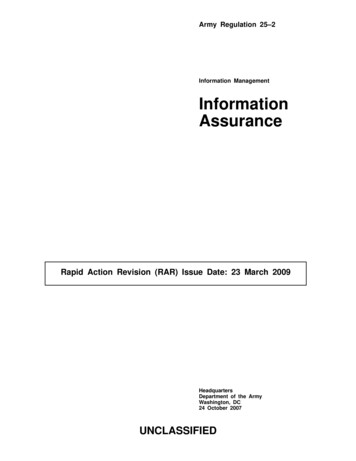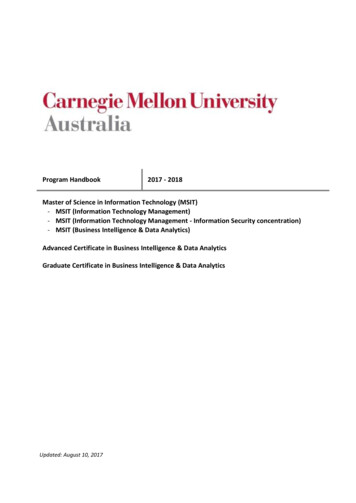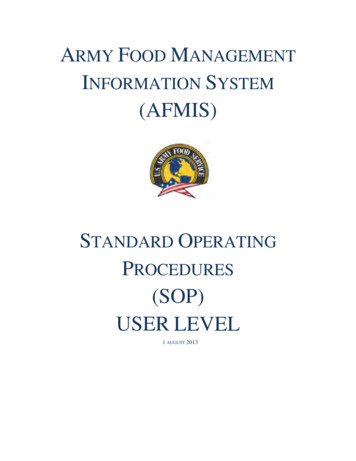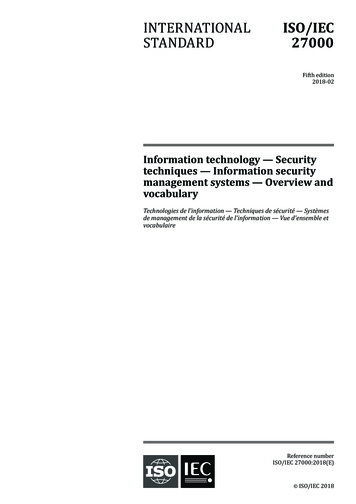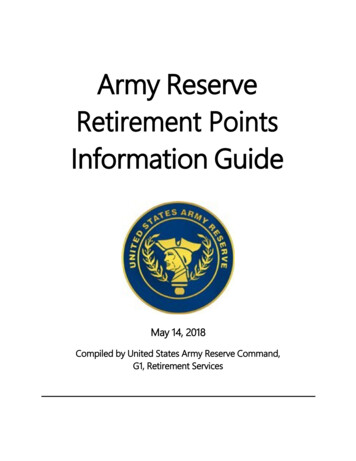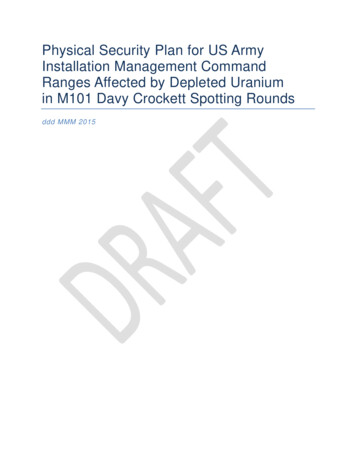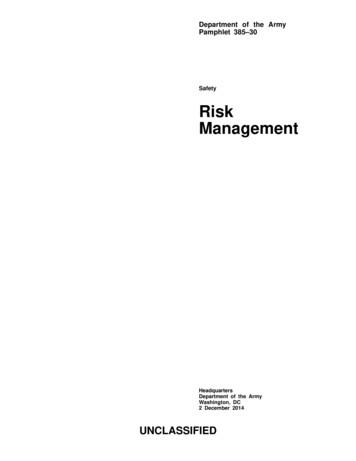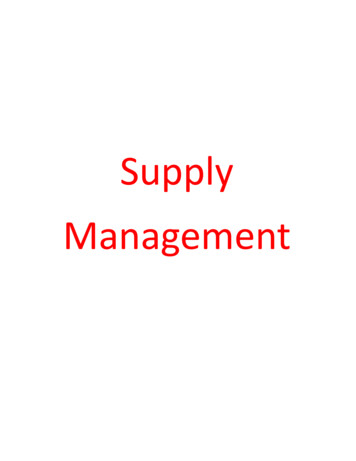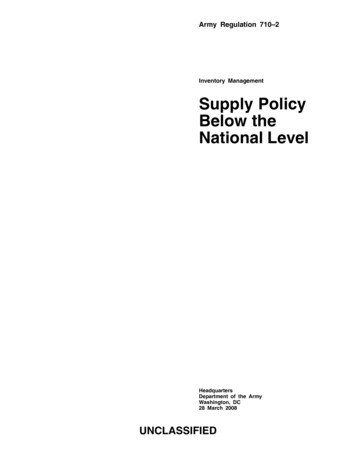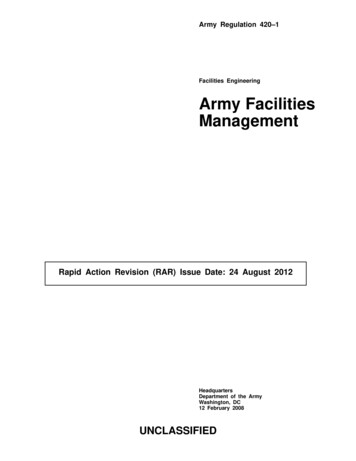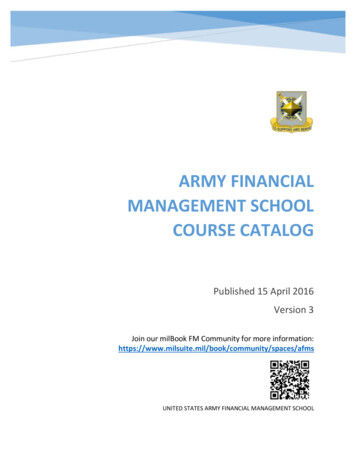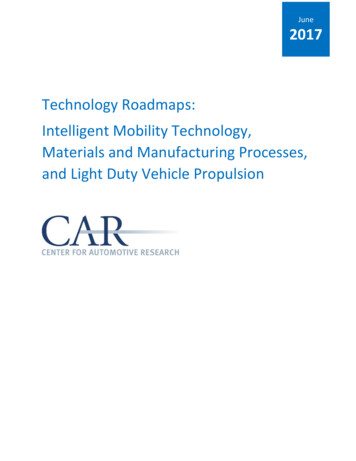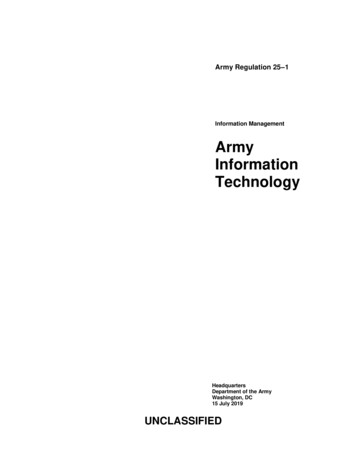
Transcription
Army Regulation 25–1Information artment of the ArmyWashington, DC15 July 2019UNCLASSIFIED
SUMMARY of CHANGEAR 25–1Army Information TechnologyThis major revision, dated 15 July 2019—oProvides guidance regarding information accountability and transparency (para 1–7).oUpdates responsibilities (chap 2).oRealigns content with Office of Management and Budget Circular A–130 (chap 3).oStructures the major tenets of information technology portfolio management planning, selection and control, funding,procurement, implementation and fielding, and oversight (paras 3–1, 3–7, 3–14, 3–18, 3–26, and 3–30, respectively).oAdds new Department of Defense Information Network life cycle replacement planning rates and activities for bothmodified table of organization and equipment and table of distribution and allowances (para 3–3).oAdds new components of the Army’s Capital Planning and Investment Control process; the Army’s InformationTechnology Investment Management approach; the Army’s Information Technology Investment ResourceManagement System; and the Army’s enterprise Information Technology governance process (chap 3).oEstablishes the Migration Implementation and Review Council chaired by the Deputy, Chief Information Officer/G–6and the Deputy, Chief Management Officer (para 3–4).oUpdates Army enterprise architecture processes (organizations, standards, compliance assessment/certification, andwaivers) (para 3–5).oAdds Army civilian information technology management (para 3–6).oIncorporates new Internal Use Software policy guidance in accordance with Department of Defense FinancialImprovement and Audit Readiness Guidance establishing Internal Use Software as a Mission Critical Asset category,which is material to the financial statements of the Department of Defense and the Army (para 3–15).oExpands use of the Army Information Technology Approval System as a policy compliance tool that enables the Armyto respond to public law, congressionally-directed actions, and Army policy (para 3–16).oNames the Army-Air Force wireless NexGen Blanket Purchase Agreement as the service plan for commercial mobilewireless devices (paras 3–19 and 3–30).oExpands Army Data Management Program guidance (para 3–33).oProvides new Armywide strategic planning policy guidance for standard Army life cycle replacement of informationtechnology assets (para 3–40).oUpdates temporary exception to policy guidance and replaces global information grid waiver with CommercialInternet Service Provider and Network Temporary Exception to Policy waiver (para 3–41).oDeletes telecommunications and unified capabilities guidance (formerly para 4-1a(4)).
oDeletes the Defense Information Assurance Certification and Accreditation Process, Information Assurance,Information Assurance Vulnerability Alert, Certificate of Networthiness, and other cybersecurity policies, compliancerequirements, and procedures from this regulation and refers to AR 25–2 and associated cybersecurity pamphlets forthe latest policy guidance (para 4–16).oTransfers Army Portfolio Management Solution Business Rules from this regulation and places it in DA Pam 25–1–1(formerly appendix B).oEnhances the internal control evaluation (appendix B).oIntroduces the acronym “DODIN–A” (the Army’s portion of the Department of Defense Information Network)(throughout).oRelocates previous detailed governance and network implementation guidance, processes, and procedures from AR25–1 to the supporting DA Pam 25–1–1 and other Army regulations and pamphlets (throughout).oIncorporates the following Army Directives: Army Directive 2009–03 (Army Data Management), dated 30 October2009; Army Directive 2013–02 (Network 2020 and Beyond: The Way Ahead), dated 11 March 2013; Army Directive2013–26 (Armywide Management of Printing and Copying Devices), dated 2 December 2013; and Army Directive2016–18 (Divesting Legacy Information Technology Hardware, Software, and Services in Support of the ArmyNetwork), dated 22 June 2016 (throughout) (hereby superseded).
HeadquartersDepartment of the ArmyWashington, DC15 July 2019*Army Regulation 25–1Effective 15 August 2019Information ManagementArmy Information Technologyinvestment strategy), performance meas- identifies key internal controls that must beevaluated (see appendix B).urements, acquisition, and training.Applicability. This regulation applies tothe Regular Army, the Army NationalGuard/Army National Guard of the UnitedStates, and the U.S. Army Reserve, unlessotherwise stated. It also applies to platformInformation/Technology/Industrial ControlSystems; appropriated-funded morale, welfare, and recreation support systems; nonappropriated-funded morale, welfare, andrecreation support systems; and to contractor-owned/contractor-operated systems operated on behalf of the Army. During mobilization, procedures in this publication canHistory. This publication is a major revi- be modified to support policy changes asnecessary.sion.Summary. This regulation establishes Proponent and exception authority.policies and assigns responsibilities for in- The proponent of this regulation is theformation management and information Chief Information Officer/G–6. The propotechnology. It applies to information tech- nent has the authority to approve exceptionsnology contained in both business systems or waivers to this regulation that are conand national security systems (except as sistent with controlling law and regulations.noted) developed for or purchased by the The proponent may delegate this approvalDepartment of Army. It addresses the man- authority, in writing, to a division chiefagement of information as an Army re- within the proponent agency or its direct resource, the technology supporting infor- porting unit or field operating agency, in themation requirements, and the resources grade of colonel or the civilian equivalent.supporting information technology. This Activities may request a waiver to this regregulation implements Title 40, United ulation by providing justification that inStates Code, Subtitle III (40 USC, Subtitle cludes a full analysis of the expected beneIII); 44 USC, Chapters 35 and 36; 10 USC fits and must include formal review by the2223 and 3014; and DODD 8000.01. It es- activity’s senior legal officer. All waiver retablishes the Army’s Chief Information Of- quests will be endorsed by the commanderficer and the full scope of the Army Chief or senior leader of the requesting activityInformation Officer’s responsibilities and and forwarded through their higher headmanagement processes. These processes in- quarters to the policy proponent. Refer tovolve strategic planning, capital planning, AR 25–30 for specific guidance.Supplementation. Supplementation ofthis regulation and establishment of command and local forms are prohibited without prior approval from the Chief Information Officer/G–6 (SAIS– PRG), d improvements. Users areinvited to send comments and suggestedimprovements on DA Form 2028 (Recommended Changes to Publications and BlankForms) directly to Office of the Chief Information Officer/G–6 (SAIS– PRG), 107ArmyPentagon,Washington,DC20310–0107 or email: .mil.Committee management. AR 15–1requires the proponent to justify the establishment or continuation of a committee(s),coordinate draft publications, and coordinate changes in committee status with theOffice of the Administrative Assistant tothe Secretary of the Army, Department ofthe Army Committee Management Office(AARP–ZA), 9301 Chapek Road, Building1458, Fort Belvoir, VA 22060–5527. Further, if it is determined that an established“group” identified within this regulation,later takes on the characteristics of a committee, as found in AR 15–1, then the proponent will follow all AR 15–1 requirements for establishing and continuing thegroup as a committee.Distribution. This regulation is availablebusiness process analysis and improve- Army internal control process. This in electronic media only and is intended forment, assessment of proposed systems, in- regulation contains internal control provi- the Regular Army, the Army Nationalformation resource management (to include sions in accordance with AR 11–2 and Guard/Army National Guard of the UnitedStates, and the U.S. Army Reserve.Contents (Listed by paragraph and page number)Chapter 1Introduction, page 1Purpose 1–1, page 1*This regulation supersedes AR 25-1, dated 25 June 2013 and the following Army Directives (ADs): AD 2009-03, dated 30 October 2009; AD 2013-02, dated11 March 2013; AD 2013-26, dated 2 December 2013; and AD 2016-18, dated 22 June 2016.AR 25–1 15 July 2019UNCLASSIFIEDi
Contents—ContinuedReferences and forms 1–2, page 1Explanation of abbreviations and terms 1–3, page 1Responsibilities 1–4, page 1Records Management (recordkeeping) requirements 1–5, page 1Overview 1–6, page 1Information accountability and transparency 1–7, page 1Information technology governance and management by mission areas 1–8, page 2Information technology oversight council 1–9, page 2Chapter 2Responsibilities, page 3Headquarters, Department of the Army principal officials 2–1, page 3Under Secretary of the Army 2–2, page 3Assistant Secretary of the Army (Acquisition, Logistics, and Technology) 2–3, page 4Assistant Secretary of the Army (Civil Works) 2–4, page 5Assistant Secretary of the Army (Financial Management and Comptroller) 2–5, page 5Assistant Secretary of the Army (Installations, Energy and Environment) 2–6, page 5Assistant Secretary of the Army (Manpower and Reserve Affairs) 2–7, page 5General Counsel 2–8, page 5Administrative Assistant to the Secretary of the Army 2–9, page 5Chief Information Officer/G–6 2–10, page 6Chief of Public Affairs 2–11, page 11Chief, National Guard Bureau 2–12, page 11Director of the Army Staff 2–13, page 11Deputy Chief of Staff, G–1 2–14, page 11Deputy Chief of Staff, G–2 2–15, page 12Deputy Chief of Staff, G–3/5/7 2–16, page 12Deputy Chief of Staff, G–4 2–17, page 13Deputy Chief of Staff, G–8 2–18, page 13Chief, Army Reserve 2–19, page 13The Surgeon General/Commanding General, U.S. Army Medical Command 2–20, page 14Assistant Chief of Staff for Installation Management 2–21, page 14The Judge Advocate General 2–22, page 14Commanding General, U.S. Army Forces Command 2–23, page 14Commanding General, U.S. Army Training and Doctrine Command 2–24, page 14Commanding General, U.S. Army Materiel Command 2–25, page 15Commanding General, U.S. Army Special Operations Command 2–26, page 16Commander, U.S. Army Cyber Command 2–27, page 16Commanding General, U.S. Army Intelligence and Security Command 2–28, page 19Commanding General, U.S. Army Criminal Investigation Command 2–29, page 19Commanding General, U.S. Army Corps of Engineers 2–30, page 19Commanding General, U.S. Army Test and Evaluation Command 2–31, page 19Commanding General, U.S. Army Installation Management Command 2–32, page 20Commanders of Army commands/Army service component commands/direct reporting units/and Army Reserve Component commanders (as authorized by their respective Headquarters, Department of the Army elements) 2–33, page 20Commanders of Army service component commands 2–34, page 21Commanders or directors of major subordinate commands, field operating agencies, and separately authorized activities,tenant, and satellite organizations 2–35, page 22Joint Force Headquarters-State, U.S. Army Reserve Command, or comparable-level community commanders 2–36, page 22U.S. Army Center for Army Analysis 2–37, page 22U.S. Army Modeling and Simulation Office 2–38, page 23U.S. Army Capabilities Integration Center 2–39, page 23Program executive officers and direct reporting product managers 2–40, page 23Program, project, and product managers and information technology materiel developers 2–41, page 23Information management organizations below Headquarters, Department of the Army level 2–42, page 24iiAR 25–1 15 July 2019
Contents—ContinuedChapter 3Information Technology Governance and Investment Management, page 25Section IPlanning, page 25Introduction 3–1, page 25General 3–2, page 25Analysis 3–3, page 25Governance 3–4, page 27Enterprise architecture 3–5, page 27Civilian information technology management 3–6, page 30Section IISelect and Control page 30Analysis process 3–7, page 30Information technology investment recommendations 3–8, page 30Information technology investment selection 3–9, page 31Implementation plan 3–10, page 31Army information technology budget 3–11, page 31Control 3–12, page 31Section IIIFunding, page 31Programming and budgeting for information technology 3–13, page 31Information technology purchases (capital asset management) 3–14, page 32Management and accountability of internal use software 3–15, page 32Execution 3–16, page 34Section IVProcurement, page 34Mandatory sources for procurement 3–17, page 34Army information technology service management 3–18, page 34Commercial off-the-shelf products and services 3–19 page 34Enterprise agreements 3–20, page 35Leasing information technology assets 3–21, page 36Modifications 3–22, page 36Information technology and national security systems acquisition process 3–23, page 36Service and support agreements with Department of Defense activities 3–24, page 37Section VImplementation and Fielding, page 37Configuration management 3–25, page 37Information support plans 3–26, page 38Information technology support principles 3–27, page 38Information technology support services for Army organizations on Army installations 3–28, page 39Section VIOversight, page 39Management control mechanisms 3–29, page 39Army request for information technology 3–30, page 39Army interoperability certification 3–31, page 40Coalition interoperability assurance and validation 3–32, page 41Army data management 3–33, page 41Records management 3–34, page 43Quality of publicly disseminated information 3–35, page 43Army information technology standards 3–36, page 43Army enterprise architecture certification/compliance 3–37, page 44AR 25–1 15 July 2019iii
Contents—ContinuedProperty book accountability 3–38, page 44Army standard for life cycle replacement of information technology assets 3–39, page 44Redistribution and disposal of information technology assets 3–40, page 44Waivers 3–41, page 45Section VIIEvaluate, page 46Information technology performance management 3–42, page 46Information technology performance measurements 3–43, page 46Chapter 4Information Technology Solutions Implementation, page 47Section IDepartment of Defense Information Network—Army Operations and Cybersecurity, page 47General 4–1, page 47Mission Areas 4–2, page 48Information transport 4–3, page 49Computing infrastructure 4–4, page 49Section IIUser Facing Services, page 52Collaboration tools standards 4–5, page 52Websites and services 4–6, page 53Web access blocking 4–7, page 54Establish secure connections for all Army websites and web services 4–8, page 54Other private websites (intranets and extranets) 4–9, page 54Email services 4–10, page 55Responsible use of internet-based capabilities 4–11, page 56Visual information management 4–12, page 58Publishing and printing 4–13, page 59Morale, welfare, and recreation activities and non-appropriated fund instrumentalities 4–14, page 61Telework 4–15, page 62Section IIIDepartment of Defense Information Network Operations and Cybersecurity, page 62Department of Defense Information Network Operations and Cybersecurity 4–16, page 62Maintaining the Army’s Hardware and Software Baseline 4–17, page 62Army’s Risk Management Framework 4–18, page 63Identity and access management 4–19, page 63Privacy Impact Assessment 4–20, page 64Electromagnetic spectrum operations 4–21, page 64AppendixesA. References, page 66B. Internal Control Evaluation, page 77Table ListTable 3–1: Capitalization of Development Cost, page 33Table 4–1: Required visual information forms, page 59Figure ListFigure 4–1: Mission areas and their domains within the Army, page 48ivAR 25–1 15 July 2019
Contents—ContinuedGlossaryAR 25–1 15 July 2019v
Chapter 1Introduction1 –1. PurposeThis regulation establishes policies and assigns responsibilities for information management (IM), data management, andInformation Technology (IT), to include platform IT (PIT) and operational technology. It provides policy for the planning,budgeting, governance, acquisition, and management of Army IT, personnel, equipment, funds, IT resources and supporting infrastructure, and services. Army organizations must adhere to basic principles throughout the information resourcemanagement (IRM) process.1 –2. References and formsSee appendix A.1 –3. Explanation of abbreviations and termsSee the glossary.1 –4. ResponsibilitiesResponsibilities are listed in chapter 2.1 –5. Records management (recordkeeping) requirementsThe records management requirements for all record numbers, associated forms, and reports required by this regulationare addressed in the Army Records Retention Schedule-Army (RRS-A). Detailed information for all related record numbers, forms, and reports are located in Army Records Information Management System (ARIMS)/RRS-A athttps://www.arims.army.mil. If any record numbers, forms, and reports are not current, addressed, and/or published correctly in ARIMS/RRS-A, see DA Pam 25–403 for guidance.1 –6. OverviewArmy IT is defined in simple terms as the capabilities and investments that provide the combination of hardware, software,and networks that generate readiness, enable mission-command, and enhance lethality across all warfighting functions.This combination includes the development, maintenance, sustainment, and security of all communications devices, networks, systems, and associated contracts, as well as personnel costs, throughout the Army in both the Operating and Generating Forces.a. Army information is a strategic asset that must be protected and shared with authorized users in accordance with thisregulation, AR 25–2, AR 380–5 and AR 530–1.b. Functional processes must be examined and streamlined to improve their effectiveness and reduce cost before investing in IT solutions to support and enable them.c. All aspects of the Army network infrastructure including information systems (ISs), applications, wireless technologies, mobile communications, and platforms will be planned, designed, developed, architected, configured, acquired, managed, operated, and protected in accordance with this regulation and AR 25–2.d. This regulation applies to IT contained in mission-command systems; intelligence systems (except as noted); weaponsystems (except as noted); business systems; and, when identified, National Security Systems (NSS) developed or purchased by the DA. This regulation does not apply directly to information systems acquired under the National IntelligenceProgram (NIP), the Military Intelligence Program (MIP), or to the operational support of intelligence and electronic warfare systems operating in a stand-alone configuration where inclusion of integrated support would not be efficient or effective.1–7. Information accountability and transparencya. Recordkeeping requirements. Records created under the purview of this regulation, regardless of content or format,will be kept, at a minimum, in accordance with the retention schedules found at https://www.arims.army.mil. The U.S.Army Records Management and Declassification Agency manages and operates the Army Records Information Management System (ARIMS). ARIMS is a role-based system designed to provide authorized personnel with web-based tools andtechnology to manage both hardcopy and electronic Army records. Additional requirements at the state level, includingstat
o Updates Army enterprise architecture processes (organizations, standards, compliance assessment/certification, and waivers) (para 3– 5). o Adds Army civilian information technology management (para . 3–6). o Incorporates new Internal Use Software policy gu
